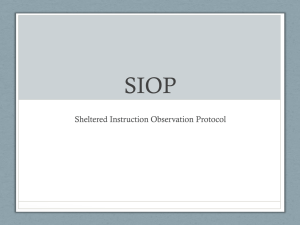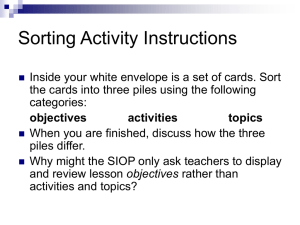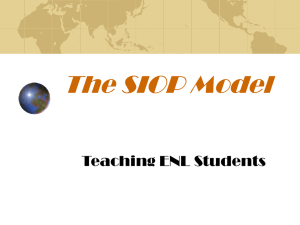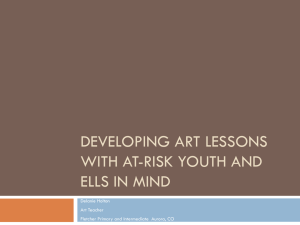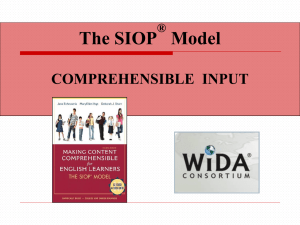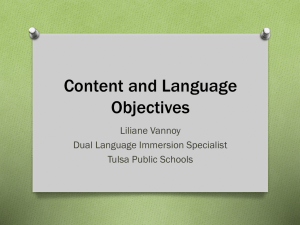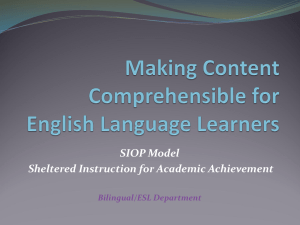BohonLeslie
advertisement
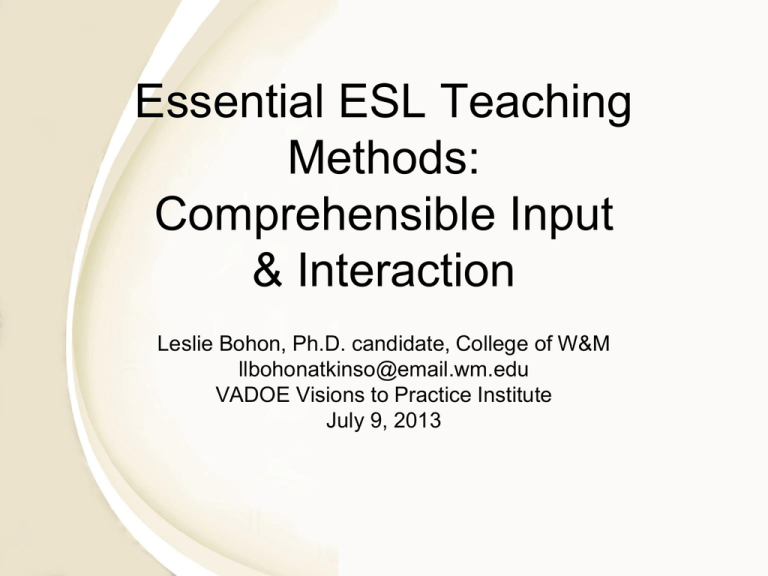
Essential ESL Teaching Methods: Comprehensible Input & Interaction Leslie Bohon, Ph.D. candidate, College of W&M llbohonatkinso@email.wm.edu VADOE Visions to Practice Institute July 9, 2013 The Growing ELL population • 1997-98 school year number of English-language learners (ELLs) enrolled in U.S. public schools: 3.5 million. • 2008-2009: increased to 5.3 million • This is a 51 % increase, as opposed to the general population increase of 7.2 % (National Clearinghouse for English Language Acquisition, 2011). • Virginia is among the top 10 states of growth in ELL numbers. Source: National Clearinghouse for English Language Acquisition (2011). The growing number of English learner students. Retrieved from http://www.ncela.gwu.edu/t3sis 2 Purpose of this session • Content objectives: – Learn more about comprehensible input and its importance to your ELLs. – Practice interactive strategies to add to your classroom tools. • Language objectives: – Discuss difference in demonstrations with comprehensible input vs. none. – Discuss with partner comprehensible input techniques you already do and those you wish to improve. – List interactive strategies you or your colleagues use; discuss with group. 3 Pre-quiz – complete with partner • 1. Teachers’ instructional discourse should be clear, enunciated. Ideal speech rate is normal yet with more between phrases and punctuation. • 2. T or F? Because ELLs are learning English, it is important for teachers to do most of the talking. • 3. T or F? Interaction helps ELLs learn cultural and social skills as well as content. • 4. T or F? Teachers should incorporate at least 2 kinds of group configurations each day. Comprehensible input = making the message understandable for students (Krashen, 1982). – – Demonstration: Note the difference between the 2 quick lessons – Krashen-style! Activity: graphic organizer on comprehensible input 5 Activity: Comprehensible input for ELLs Guiding Questions What is comprehensible input? Why is it important to use comprehensible input for ELLs? When is it important to use comprehensible input? What are some examples of comprehensible input? Activity: •Using the concept map provided to you, please 1) brainstorm answers individually, 2) share with partner. Comprehensible Input • Speech appropriate for students’ proficiency level • Clear explanation of academic tasks • A variety of techniques used to make content concepts clear Sources: Echevarria, J., Vogt, M., Short, D. (2010). Making content comprehensible for secondary English learners. Boston, MA: Pearson. Krashen, S. (1982). Principles and practice in second language acquisition. Oxford, UK: Pergamon Press. Comprehensible Input: Speech appropriate HOW teacher speaks: rate, enunciation, pauses WHAT teacher says: level of vocabulary, sentence structure, use of idioms, repetition, use of cognates –Speak at a slower rate for beginners. –Increase speaking rate with time, but use pauses. –Enunciate. English is a stress-timed language while Spanish, Korean, and Japanese are syllable-timed languages. –Avoid jargon and idiomatic expressions. –Use cognates. Many two-tiered words are cognates (i.e., calculate, television, malfunction). Sources: Echevarria, J., Vogt, M., Short, D. (2010). Making content comprehensible for secondary English learners. Boston, MA: Pearson. Krashen, S. (1982). Principles and practice in second language acquisition. Oxford, UK: Pergamon Press. Comprehensible Input: Clear explanation of tasks How can a teacher provide clear explanations? Guidelines: –Practice activities; make them routine. –Present instructions in a step-by-step manner. –Model instructions/activities. Peer modeling is wonderful. –Present the finished product, such as what you want regarding writing, a research report, a lab, etc. –Written directions to accompany oral directions. –Simplify and adapt text. Sources: Echevarria, J., Vogt, M., Short, D. (2010). Making content comprehensible for secondary English learners. Boston, MA: Pearson. Krashen, S. (1982). Principles and practice in second language acquisition. Oxford, UK: Pergamon Press. Comprehensible Input: Techniques to make concepts clear •Modeling •Hands-on activities •Demonstrations •Gestures and body language •Visuals, graphic organizers Sources: Echevarria, J., Vogt, M., Short, D. (2010). Making content comprehensible for secondary English learners. Boston, MA: Pearson. Krashen, S. (1982). Principles and practice in second language acquisition. Oxford, UK: Pergamon Press. Interaction • Frequent opportunities for interaction and discussion between teacher and students and among students that encourage elaborated responses about lesson concepts • Opportunities for students to clarify key concepts in L1 as needed with peer or L1 text Source: Echevarria, J., Vogt, M., Short, D. (2010). Making content comprehensible for secondary English learners. Boston, MA: Pearson. Interaction practice Directions: 1) Assign each group member a role (recorder, reporter, facilitator, time keeper, materials manager). 2) In the spaces below, write an example of – a technique you use to make speech comprehensible in your class and one that you wish to improve, – a technique you use to make explanations clear and one that you wish to improve, and – a technique you use to promote comprehensible input and one that you wish to improve. 3) You have 2 minutes, so work quickly. 16 Students share •Please listen to what these ELLs share about what teachers do to help them learn, including comprehensible input and interaction. •Reactions? Creating Opportunities for Interaction •Use a minimum of two group configurations (individual, pair, triads, groups of 4-5, whole group). •Have all students participate in responding to your questions (e.g., whiteboards, red-yellow-green cards) •Encourage more elaborate responses from students •Elicit more extended responses •Reduce the amount of teacher talk Importance of Interaction •Using the academic language helps solidify the content for ALL students •Language development (using English to communicate) •Learning is more effective when students form, express, discuss ideas and opinions. •ELLs learn social (cultural) skills Activity (Inner-Outer Circle) •With a partner, please list three ways that a teacher can create opportunities for interaction and cooperative learning among students. How do you get students to talk about content in your class? •Use inner-outer circle to share your responses. •Stop when clock is at 0:00. Post-quiz • 1. Teachers’ instructional discourse should be clear, enunciated. Ideal speech rate is normal yet with more _______between phrases, commas, and periods. Pauses • 2. Because ELLs are learning English, it is important for teachers to do most of the talking. False. Discussing content helps ALL students learn academic language. • 3. Interaction helps ELLs learn cultural and social skills as well as content. True • 4. Teachers should incorporate at least 2 kinds of group configurations each day. True References Buehl, D. (2001). Classroom strategies for interactive learning (2nd ed.). Newark, DE: International Reading Association. Cummins, J. (1981). The role of primary language development in promoting educational success for language minority students. In California Department of Education (Ed.), Schooling and language minority students: A theoretical framework (pp. 3-49). Los Angeles, CA: Evaluation, Dissemination and Assessment Center, California State University. Echevarria, J., Vogt, M., Short, D. (2010). Making content comprehensible for secondary English learners. Boston, MA: Pearson. Gomez, E. (1999). Opinion maker. In D.J. Short (Ed.), New ways in teaching English at the secondary level. Washington, DC: Center for Applied Linguistics. Krashen, S. (1982). Principles and practice in second language acquisition. Oxford, UK: Pergamon Press. National Clearinghouse for English Language Acquisition (2011). The growing number of English learner students. Retrieved from http://www.ncela.gwu.edu/t3sis Reiss, J. (2012). 120 content strategies for English language learners: Teaching for academic success in secondary school (2nd ed.). Boston, MA: Pearson. Vogt, M, Echevarria, J. (2008). 99 ideas and activities for teaching English learners. Boston, MA: Pearson. Vygotsky, L. S. (1978). Mind in society: The development of higher psychological processes. 22 Cambridge, MA: Harvard University Press.

